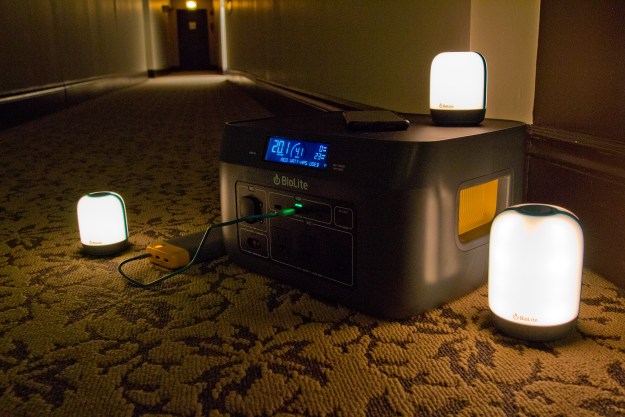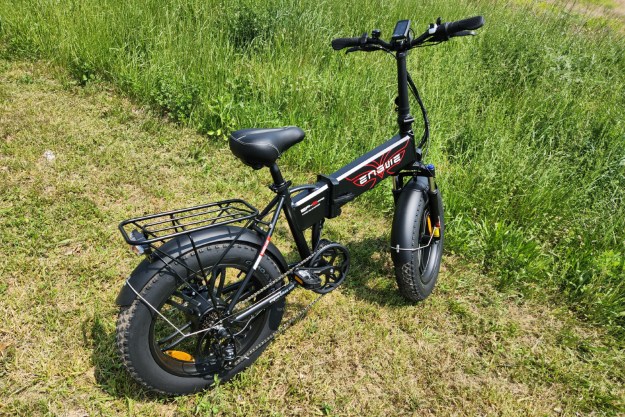
“The BioLite BaseCharge 1500 provides reliable power backup in a modern package.”
- High capacity for its weight
- Enough output for most appliances
- Streamlined design
- Built-in usage meter
- Limited solar input
- No mobile app
I was really glad to have the BioLite BaseCharge 1500 power station in my closet a couple of weeks ago. On top of being smoked like a campfire sausage thanks to Quebec wildfires, I had to contend with two days of planned power outages and a day without running bathroom water. More well-balanced people may have transplanted somewhere with clean air, running water, and electricity, but my obstinacy knows no bounds, so I fired up the BioLite and put it to the test.
The BioLite BaseCharge 1500 basics
Let’s start, as we should, with the specs.
- 1521 Wh NMC battery
- 26.5 pounds
- 3 x AC output at 1200 W, 2400 W surge
- 2 x USB-A and 2 X USB-C output at 5 V and 3 A
- 1 x DC output at 120 W
- 2 x DC5521 output at 120 W
- Wireless charging at 10 W
- 1 x USB-C input/output at 100 W
- Solar/charger input at 400 W
The plug layout mostly makes sense. The important thing is that the AC outputs are adequately spaced to accommodate larger plugs. I’ve been a bit spoiled since using the EcoFlow River 2 Pro. It has all of the inputs on the back and the outputs on the front. This helps keep things much more clean, and I’d love to see other brands adopting the practice.

In terms of sheer build quality, there’s a lot to like. The air vents are tucked in subtly, beside the inset handles. This would keep them out of view if not for their stylish splash of yellow. I was really happy with the perfectly flat top used for wireless charging until I saw some very specific warnings in the documentation against stacking things on top of the battery. Power stations are heavy, so when they’re stowed in your trunk or your closet, odds are you’re going to want to pile stuff on top of them or miss out on a lot of vertical space.
An LCD provides all the relevant charging and output data, including a dedicated button for showing and resetting a tracker for total energy usage. It’s enough information to track basic usage, but it’s a bit of a bummer that there’s no companion app to really dig in deeper.
I’ve been on a solar panel kick lately and was disappointed in the lack of compatible inputs on the BioLite BaseCharge 1500. It has a relatively obscure high power pole (HPP) input that should work just dandy with BioLite’s own solar panels, but not with the 1-pin 12-28V DC I see on most other power stations or XT60 connectors. Goal Zero is the only other battery brand that I see using these HPP plugs. Whatever standard you’re using, power stations generally need adapters for the MC4 plugs that come out from the solar panels. I resent needing to get yet another adapter to get my existing panels to work.
BioLite BaseCharge 1500 performance

In real-life performance, the BioLite BaseCharge 1500 was able to keep my laptop, monitor, and phone charged through two full workdays. The output was also high enough to bring water in my 1500W kettle to a boil. That exceeds the BaseCharge’s listed 1200W rating but falls below the 2400 W surge rating. BioLite says the BaseCharge can keep a microwaving going for over an hour, but it couldn’t run my 1100W unit. To be fair, neither could any of the other power stations I’ve looked at.
At 26.5 pounds, the BaseCharge 1500 is no featherweight, but it’s on the low side for its 1.5kWh capacity. The similar Jackery 1500 Pro, for instance, weighs 37.4 pounds. BioLite offers a smaller 622Wh model, if you’re looking for more portability.
From empty, the whole thing took about 12 hours to charge over AC input. This was shorter than the listed 13.5 hours. If you’re in a real rush, you can also charge via the USB-C simultaneously to cut it down to 8 hours. Our Emporia smart plug showed the full charge pulling around 1,700 Wh from the wall, notably higher than the listed 1521 Wh capacity, and measured just under 1,200 Wh on discharge. That means you lose about 30% of your energy in the process of storing it in a battery and pulling it back out.
The BioLite BaseCharge 1500 battery chemistry is nickel manganese cobalt, which is a divergence from the growing trend toward lithium iron phosphate (LiFEPO4). NMC has higher power concentration, but less thermal stability and shorter overall lifespan than LiFePO4 — BioLite rates this model for 1,000 cycles. Moreover, cobalt is a resource that has become a humanitarian hot-button. It’s unfortunate because BioLite otherwise does great work in this sphere. Its consumer sales support electrifying and decarbonizing remote African villages. For what it’s worth, BioLite is also Climate Neutral Certified, which means the company accounts for, reduces, and offsets its greenhouse gas emissions.
Emergency preparedness kit
I didn’t receive the BaseCharge 1500 alone. It came as part of BioLite’s emergency preparedness bundle, which includes some lamps, a headlamp, and a portable battery pack, all of which came in handy during my building’s two days of blackout. The battery pack was standard fare: 74 Wh, two 5 A USB-A ports, and an 18 W USB-C input/output. The HeadLamp 325 is quite comfortable, charges over micro-USB, has a tilt mechanism, and a handful of white and red shining modes.

The AlpenGlow lamps are quite cute. There are two smaller ones and a single bigger one in this kit. They all have a similar layout, with a lone control button on top, an extendable hanging hook underneath, and USB input and output plugs tucked under rubber covers. A single button press cycles between bright white, warm white, and rainbow color modes. A press and hold adjusts brightness. You can even give it a little shake to swap between static and animated light modes. These came in handy in my bathroom and kitchen when the lights were out. The warm animated mode recreates the gentle flicker of tealight candles. These lasted long enough for one day on high brightness but needed a charge for the second. If endurance is a concern, they’re rated for 200 hours on low brightness.
The only complaint here is that the plastic used on the AlpenGlow lamps feels quite soft and scuffable. I’ve bumped into some poor plastic from BioLite in the past. This includes a broken underside cover for its CampGrill stove accessory and light bleeding from the LED indicators on its SiteLight lamp. I worry about the AlpenGlow lights falling into the same camp, but luckily the BaseCharge itself feels solid.
BioLite BaseCharge 1500 verdict

I’ve been a big fan of BioLite camp stoves for a long time. It’s great to see them spreading out into a few other product categories, but players like EcoFlow, Jackery, and Bluetti have a big head start.
A nice mobile app is a big challenge, but a necessary one in order for BioLite to be competitive. Still, this is a great first stab at a mid-sized power station. If nothing else, BioLite shows mindfulness for aesthetics that few others in the space do.
Price is going to be a hard thing to fight on. The BioLite BaseCharge 1500 is $1,359 on its own. The extra $100 for the emergency kit is quite good value. The Bluetti AC200P is cheaper at $1,200 and offers a higher 2000 Wh capacity with more outputs. The Jackery 1500 offers specs similar to the BaseCamp 1500 for $1,299. BioLite does, however, beat Goal Zero on the price of the Yeti 1500X at $1,799.
Suffice it to say, the BioLite BaseCamp 1500 performs well but will need more standout features to justify its price in relation to its competitors.



